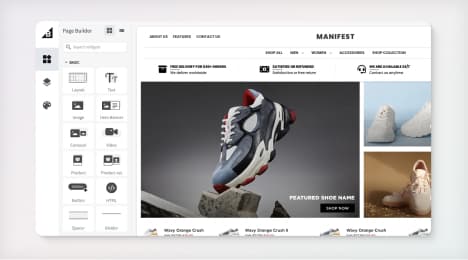
Watch Our Product Tour
See how BigCommerce helps you build and manage your online store with ease.
- Ecommerce Insights

6 Key Steps to Launch Your Online Store
Explore our Launch Foundations series to get your BigCommerce store up and running quickly.
BigCommerce helps growing businesses, enterprise brands, and everything in-between sell more online.
What is Double Opt-in?
When you’re getting started with email marketing and setting up signup forms to grow your email list, you may have encountered an option to enable a double opt-in process. Unless you’re a seasoned email marketer, it can be hard to know whether you should enable this option and how it’ll affect the signup process for your subscribers.
There are, however, several reasons why you should seriously consider using a double opt-in process. You should also be aware of some of the drawbacks of double opt-in compared to the more common single opt-in approach.
By understanding exactly what double opt-in is and its advantages and disadvantages, you’ll be able to make an informed decision on the best way to proceed with your email marketing.
Defined: Email Double Opt-in
Double opt-in is the process of requiring new subscribers to complete a second task when signing up for your email list. In practice, this almost always takes the form of sending the new subscriber an email to confirm their intention to sign up.
This confirmation email is sent after the person wishing to sign up to the email list enters their email address into the signup form and clicks on the “sign up” (or similarly worded) button. Instead of seeing a message that their signup has been confirmed, they are prompted to check their inbox for a confirmation email.
Within this confirmation email, there will be a button or a link that they need to click to finalize the process. Only after clicking this link will they be added to the email list.
Differences Between Single and Double Opt-in
The key difference between single and double opt-in is the number of steps someone must take to sign up for your email list.
With single opt-in, new subscribers are added to your email list after they type their email address in and click on the “sign up” button (as well as potentially having to tick an agreement checkbox).
This part of the signup process remains identical when using double opt-in. The only difference is the additional step of the confirmation email and link.
While it might seem like all this additional step does is to create extra work for your subscribers, it provides plenty of potential benefits for your email marketing.
What are the Advantages of Double Opt-in?
When nearly half of professional email marketers prefer double opt-in to the single opt-in process, there must be some compelling advantages to adding the additional step. Some of the most cited benefits are:
1. Acquiring more qualified contacts.
Generating and sustaining email engagement, such as decent open rates, is an ongoing challenge for email marketers. Poor engagement is often attributed to subscribers losing interest in receiving your emails.
Requiring new subscribers to complete an extra step when signing up is seen as a way to verify that they are interested in receiving your emails. After all, anyone who can’t be bothered to click on a confirmation link to confirm their subscription isn’t likely to be all that interested in your emails anyway.
Double opt-in also does a great job of ensuring that email addresses are legitimate. Whether it’s people merely mistyping their address or deliberately using a fake or temporary address to access your opt-in incentive (such as a free ebook or guide), you only want to be sending emails to real addresses.
With double opt-in, if someone uses a fake email address or mistypes their actual address, they won’t be able to receive the confirmation email to confirm their subscription. This keeps your email list clean and protects your sender reputation.
2. Avoid issues with GDPR.
Perhaps the most common reason email marketers like double opt-in is that it provides a clear signal that all of your subscribers actively agree and want to be on your email list.
Many data privacy and security laws around the world, especially the GDPR and the CCPA, require that you only send marketing emails to subscribers who have clearly and unambiguously agreed to receive them. There is also often a legal requirement that you explain exactly how their data (e.g., email address) will be used.
In addition to explaining this and getting permission at the signup form on your website, the double opt-in confirmation email is the perfect opportunity to reiterate how someone’s data will be used and for them to grant their permission by clicking on the confirmation link.
The double opt-in process also removes the possibility of a subscriber being signed up to your email list without their consent by someone else.
While the GDPR doesn’t explicitly require email marketers to implement double opt-in, and this shouldn’t be taken as legal advice, many marketers have decided to use it. If for no other reason than to provide peace of mind.
3. Create stronger relationships with new contacts.
Having people go to their inbox and open the double opt-in email is a great way to filter out those who aren’t all that interested in being on your list. Those who complete both steps are the ones who are going to be the most engaged with your future emails.
This will mean you’ll enjoy a stronger relationship with your email list and they’ll be opening and clicking on your emails at a much higher rate. A GetResponse study found that click rates on email lists with double opt-in were on average twice that of email lists with single opt-in.
Even though it’s nice to have a large email list, having a healthy email list is more important. Especially when most email service providers charge based on how many subscribers you have. By implementing double opt-in, you can be more assured that the subscribers on your list are worth having.
Advantages of Single Opt-in
Despite the advantages of a double opt-in process, there is one big reason why many email marketers stick with single opt-in: it delivers more signups.
A significant portion of people simply don’t complete the second step associated with double opt-in. ClickZ puts this percentage as high as 20%. That’s a large percentage of potential subscribers you might miss out on.
While a lot of people who don’t complete the second task are those who you likely don’t want on your email list anyway, chances are some would’ve been engaged subscribers.
These people may not have realized they have to confirm their subscription, didn’t have access to their inbox at the time and forget about it, or just got frustrated. Whatever the reason, these are potential leads you could be missing out with a double opt-in process.
Conclusion
Unfortunately, there’s no clear cut answer to which method is best and opinion among professional email marketers is split. But now that you have a clear understanding of what double opt-in is, how it differs from single opt-in, and the rationale behind both approaches, you can make an informed decision on which method to use.
If you’ve noticed you’ve been receiving spam complaints or you’re growing your email list but are having trouble getting your new subscribers to engage with your campaigns, then it might be worthwhile trying double opt-in.
And if you’re truly unsure of which approach to take, it might be something you want to A/B test to see what effect both approaches have on your email engagement metrics like open and click-through rate.
BigCommerce helps growing businesses, enterprise brands, and everything in-between sell more online.
Start growing your ecommerce business even faster.
High-volume or established business? Request a demo